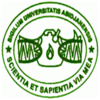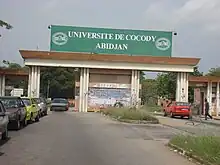Université Félix Houphouët-Boigny
Université Félix Houphouët-Boigny (UFHB) (formerly known as University of Cocody-Abidjan, fr.: Université de Cocody or Université de Cocody-Abidjan) is an institution of higher education located in the Cocody section of Abidjan and the largest in Côte d'Ivoire. With over 50,000 students, the UFHB has 13 faculties and several research centers providing diplomas from two-year undergraduate to professional academic, medical, legal, and specialist degrees. From 1964 to 1996, it remained the main campus of the national University of Abidjan system. It is state owned and operated by the Ministry of Higher Education and Scientific Research. In 2008, it had 53,700 students.[1]
 | |
| Latin: Sigilium Universitatis Abidjansis | |
Former names | University of Abidjan-Cocody (-August 1996) |
|---|---|
| Motto | "Scientia et Sapientia Via Mea" |
| Type | Public |
| Established | 9 January 1964 |
| President | Professeur Bakayoko Ly Ramata |
| Students | 50,000 |
| Location | , |
| Campus | 01 BP V34 Abidjan, République de Côte d'Ivoire |
| Colours | Green, White |
| Website | https://univ-fhb.edu.ci/ |


History
UCA was an outgrowth of two French founded institutions from 1958. The Ecole des Lettres d’Abidjan (E.L.A.) founded in October 1958, under the joint administration of the University of Dakar and the Ivorian education directorate ("Direction de l’enseignement de Côte d’Ivoire"). Founded on the same date was the Abidjan Center for Higher Education ("Centre d’enseignement supérieur d’Abidjan").
On 9 January 1964 the government of Côte d'Ivoire fused the institutions and promoted them to the rank of university.[2] The public university system was, until reorganization in 1996, known as the University of Abidjan, with the University of Abidjan-Cocody as the largest of three campuses.
In the reorganization of August 1996, each of the three main campuses became independent universities, accountable directly to the Ivorian Ministry of Education. (The three are the Université d'Abobo-Adjamé, the Université de Bouaké, and the Université de Cocody.) At this time the "Faculties" were re-designated "Unités de formation et de recherche" (UFR) or "Research and Training Units" (RTU). The university consisted of 13 UFRs and one "Center".[3] The number of special research centers and institutes have since expanded. In 2008 there were two Autonomous Research Centers in Social Sciences and Mathematics, as well as ten institutes of advanced study.[4]
In 1971, students at the university founded the Pupils and Students Trade Union of Côte d'Ivoire (Union Syndicale des Elèves et Etudiants de Côte d'Ivoire or USEEECI) in protest of the regime-sponsored Students and Pupils Movement of Côte d'Ivoire (MEECI).[5][6]
The institution's name was changed to Université Félix Houphouët-Boigny in August 2012.[7]
Faculties
FLASH
In 1971, the School of Letters (formerly the E.L.A.) became the "Faculté des Lettres, Arts et Sciences Humaines" (FLASH). In 1977, the Department of History, for example, moved from offering only undergraduate courses ("Premier cycle") and began to offer "Deuxième cycle" and "Troisième cycle" diplomas (Master's degrees and PhD).[2]
Autonomous research centers
- Centre Ivoirien de Recherche Economique et Social (CIRES), Ivorian center of economics and social sciences
- Institut de Recherches Mathématiques (IRMA), Institute of mathematics
Other institutes and centers
- Centre National de Floristique (CNF)
- Centre Universitaire de Recherche d’Application en Télédétection (CURAT)
- Institut de Géographie Tropicale (IGT)
- Institut d’Histoire, d’Arts et d’Archéologie-Africains (IHAAA)
- Institut d’Ethno-Sociologie (IES )
- Centre de Recherche Architecturales et Urbaines (CRAU)
- Centre Ivoirien d’Enseignement et de Recherche en Psychologie Appliquée (CIERPA)
- Institut de Recherche, d’Expérimentation et d’Enseignement en Pédagogie (IREEP)
- Institut de Linguistique Appliquée (ILA)
- Institut des Sciences Anthropologiques du développement (ISAD)
Notable faculty
Notable alumni
See also
References
- Notes
- Présentation de l´Université de Cocody-Abidjan Archived 16 October 2008 at the Wayback Machine. Université de Cocody 2001–2008. Accessed 11 May 2009
- Côte d’Ivoire Archived 7 March 2009 at the Wayback Machine: département d’histoire de l’université de Cocody-Abidjan. histoire-afrique.org. 28 septembre 2007
- Akira Sato, Manso Lasm, Adiko Aimee (2003) pp.19, 27–28
- Instituts et Centres de Researches Archived 16 October 2008 at the Wayback Machine. Université de Cocody 2001–2008. Accessed 11 May 2009
- N'Da (p.), 1987 - Les intellectuels et le pouvoir en Afrique noire, Paris, L'Harmattan, coll. "Logiques sociales", p. 105; cited in Proteau, Laurence, March 1996 - École Et Société En Côte-D'ivoire: Les Enjeux Des Luites Scolaires (1960–1994), pp. 129–130
- Gbagbo, Laurent. Côte-d'Ivoire : Pour une alternative démocratique (in French). Editions L'Harmattan. ISBN 978-2-296-29886-6.
- Cameroon Voice
- "Ramata Ly-Bakayoko, première Ivoirienne à l'Académie des sciences d'outre-mer de Paris". Le Monde.fr (in French). 8 March 2019. Retrieved 15 February 2020.
- "Compte rendu du Conseil des ministres du jeudi 1er mars 2018". Service d'Information du Gouvernement (sig.bf). Retrieved 22 April 2021.
- Bibliography
- Akira Sato, Manso Lasm, & Adiko Aimee. Inventaire de L'Enseignement Superieur en Cote D'Ivoire. The Africa Research Series No. 08, Institute of Developing Economies, Japan External Trade Organization (IDE-JETRO). (2003)
